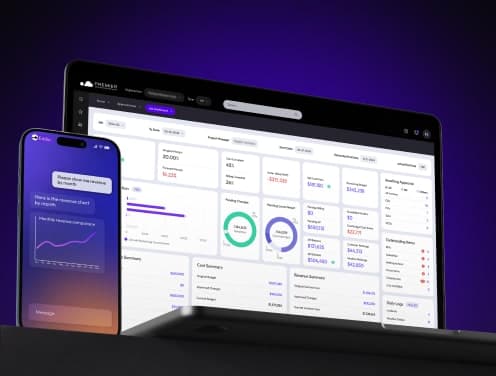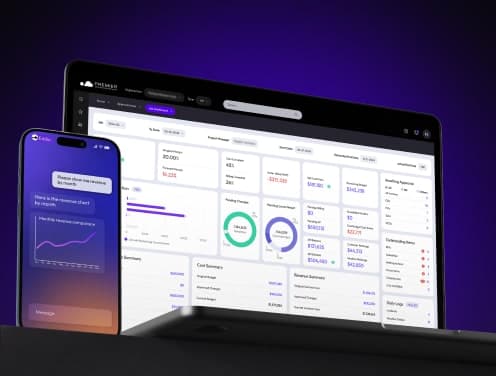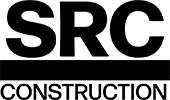
Predictive Analytics in Construction - How AI is Enhancing Business & Project Forecasting & Risk Management
The construction industry is evolving very fast, and in the case of advanced project performance, predictive analytics has been one of the prime drivers. According to statistics, companies using predictive analytics can decrease overruns in projects by as much as 30%. It is very important for construction professionals that with the increase in efficiency demands, the ability to understand the role AI can play in forecasting and risk management becomes an imperative.
Data analytics is uplifting the way construction firms plan and execute projects. Predictive analytics uses historical data to estimate the occurrence of a risk and also helps in optimum resource allocation. Using these insights together, companies can make deeper business decisions and optimize their overall performance.
In this article, we would be discussing the role of predictive analytics in the construction business regarding its applications, advantages, and the challenges which firms may face in implementing predictive analytics. Take a seat and fasten your seatbelt as we unravel some future trends that change how the construction industry approaches project management.
Key Concepts of Data Analytics in Construction
Predictive analytics in construction serves to reduce the overall cost as well as increases efficiency. It is built on the principle of using past data in order to forecast the cost of a job, timeline, and requirement of resources. In this manner, it optimizes the two most crucial activities related to project delivery: planning and execution of a project, since the existing plans are gauged against historical data.
At an early stage in the project life cycle, issues can be detected with the help of data analytics software. It automates repetitive tasks, freeing up employees' time to focus on high-level planning and coordination. It integrates various data sources, such as sensor readings and drone imagery, to provide professionals in the construction industry with a well-rounded view of projects.
- Key Benefits:
- Correct estimation of job costs
- Effective resource allocation
- Timely identification of potential project hurdles
- Automation of routine tasks
Reliable and accurate data access is crucial. Fragmented data sources can only lead to inaccurate predictions. Full integration of the data sources is, therefore, quite important in applying predictive analytics.
The Role of Data Analytics
Data analytics revolutionizes construction processes by letting accurate cost estimation and efficient resource allocation take place. Predictive models, coupled with historical data analytics, better project planning, and competitive bidding, enhance the game. This also helps in acting well in advance against environmental impacts that would put the construction teams in a difficult position regarding regulatory issues.
- Areas of Impact:
- Environmental impact assessments
- Proactive safety measures
- Improved bidding processes
By offering predictive insights, construction companies will be better equipped to reduce risks and make their project sites much safer. Advanced analytics, like data mining, also allow for truly forward-looking cost estimates—intelligent and quite different from traditional anecdote-based methods. Further successful integration of such data insights into the workflow of the leading teams requires the availability of reliable sources of data and conditions for training.
What is Predictive Analytics?
Predictive analytics depends upon data, statistical algorithms, and machine learning techniques to make predictions about future events. It's about giving insights that go beyond what happened in the past and painting a picture of what will happen in the future to create insightful decisions. In construction, predictive analytics can also improve financial planning by considering regional labor and material costs.
- Applications in Construction:
- Budget forecasting
- Timeline predictions
- Resource planning
Advanced modeling techniques, using artificial intelligence, find patterns in the data that help project more accurate timelines and productivity. Predictive analytics provides an organization method to lower costs while increasing operational efficiency by making informed decisions based on correct forecasts for better project management and successful construction projects.
Importance of Data Analytics in Construction
The construction industry is one that is pressured to just finish projects on time and within budget. Predictive analytics is quite vital in overcoming these challenges. Taking a lesson from history, construction teams make fairly accurate estimates of the cost of jobs and timelines by analyzing past data. This ensures that resources are distributed based on actual needs, minimizing the chances of cost overruns.
Predictive analytics further helps in pinpointing the actual inefficiencies, such as material wastes and poor resource utilization, which eventually enhances budgeting and streamlines the workflows. Such a proactive approach reduces risks taken on and heightens the chances of completing projects on time. Data-driven decisions are also helping stakeholders evaluate different approaches at any given stage in the process and consider design changes. This improves project results through more accurate forecasting and real-time visibility of jobsite conditions and equipment performance.
Key benefits of predictive analytics in construction include:
- Accurate estimation of costs and timelines
- Reduction in material waste and improved resource allocation
- Streamlined workflows and risk mitigation
- Enhanced decision-making with real-time data
- Improved project outcomes
This leads to improved outcomes of projects. In this respect, predictive analytics can help construction companies manage the life cycles of projects better by rendering insights that help in successful completion. This technology is integral to the construction manager in search of operational efficiency and competitiveness within a merciless industry.
Applications of Construction Analytics
Predictive analytics in construction management allows the project manager to use historical and, simultaneously, real-time data to inform them about what is likely to happen in the future. This informed decision enables resource allocation effectively. With increasing integration, construction analytics enhances many phases of the construction process.
Improved Project Planning
Construction analytics also allows teams to simulate and visualize the design before actual construction commences, which reduces risks. Scenario evaluation is amplified by the integration of BIM with real-time data sources like material costs. Predictive analytics ensure the accuracy of material forecasting and enhances overall productivity alignment to project schedules.
Enhanced Resource Management
Predictive analytics are of great importance, enabling proper resource allocation. With real-time and historical data, project managers are able to accurately identify material quantities, hence increasing utilization of both labor and equipment. This optimizes operations, minimizes waste, and leads to greater efficiency of projects while managing costs.
Real-time Monitoring
Real-time monitoring creates complete visibility regarding project progress. Technologies like LiDar and drones capture site condition data to help identify problems proactively. Digital twins create continuous building progress assessment, while wearables enhance on-site worker safety by monitoring workers' vital signs.
Automated Progress Tracking
Automated progress tracking uses advanced technologies like laser scans in propelling data-driven supervision with minimal human effort. For example, Avvir aligns the captured conditions against original BIMs to identify deviations. This system ensures that what is being built is aligned with planned designs for proper adherence to schedules and budget maintenance.
AI-Powered Estimation
AI-powered estimation has increased accuracy in cost by minimizing manual errors. This software integrates a variety of cost factors, such as local labor rates, into the estimation process. AI helps contractors create workable budgets through the analysis of historical data and fully informs decision-making thanks to amply supported cost evaluations.
All these applications put together show the transformational effect of predictive analytics in construction and the way to smarter, better project management.
Benefits of Predictive Analytics
Predictive analytics is revolutionizing the construction industry. With predictive analytics, managers can forecast future outcomes by leveraging historical and real-time data in making informed decisions for better resource allocation. It lets users develop more accurate budgets, considering regional labor and material costs to reflect more realistic project costs. By performing trend analysis, project managers can estimate and identify potential issues in advance, plan resources optimally, and minimize risk factors. Consequently, enhanced scheduling reduces costs and delays, hence improving project outputs.
Process Optimization
All construction managers benefit from analyzing historical and real-time data for better decision-making and resource optimization. Integration of BIM with live data allows professionals to simulate designs, optimizing project plans and reducing pre-construction risks. Real-time monitoring through sensor data provides a comprehensive view of project progress and captures critical information, such as temperature and structural integrity. Integrated construction management software monitors contractor performance to facilitate improvements and collaboration. Accurate budgeting and planning are ensured by tracking real-time field production data.
Risk Mitigation
Predictive analytics enhances risk mitigation by analyzing safety incidents and their related variables to identify potential risks early. Such preemptive measures boost job site safety, reducing accidents. Understanding the correlations between project factors and safety incidents leads to better safety strategies. Predictive analytics lowers the occurrence of accidents and claims, which in turn reduces insurance costs. This data-driven approach fosters a proactive safety culture within construction projects.
Actionable Insights for Managers
With predictive analytics, project managers gain a clearer understanding of when challenges may arise and where resources are best utilized, yielding better results. More accurate budgets are developed by focusing on regional labor and material costs from the start. Real-time updates allow issues to be addressed before they impact the project, avoiding traditional delays. Machine learning analyzes historical data to predict future performance, supporting data-driven decision-making. Construction management software tracks daily operations, keeping stakeholders informed and helping to prevent costly errors.
In this regard, predictive analytics tools are essential for construction managers to streamline processes, reduce risks, and enhance efficiency across all phases of a construction project.
Evolution of Construction Practices
The construction industry is undergoing gradual shifts from the hitherto traditional way of doing things into a data-driven approach. Predictive analytics in construction management enables professionals to make informed decisions by both learning from historical and analyzing real-time data. It has key implications for resource optimization efficiency and project completion within the stipulated times. Traditional waterfall project management gambles with delays, but the data-driven approach provides better planning and simulation before the actual commencement of construction. Advanced technologies like predictive analytics, machine learning, and artificial intelligence are being infused into construction bids and project management.
Transition from Manual Processes
AI software helps in the migration from manual processes in construction, slashing the time it takes to make measurements and calculations. This reduces human error, therefore increasing the accuracy of estimation. Bidding correctness is a must: underestimation cuts profits, whereas overestimation loses projects. AI will, on its own, evaluate construction costs; hence, there will be more accuracy in budgeting without the need for manual inputs. Predictive analytics tools better predict delays and offer alternatives to the old way of tracking progress. Analytics-based decision-making provides high efficiency for firms, utilizing most of the project information for both present and future needs.
Adoption of Digital Tools
Predictive analytics provides construction business enterprises an effective means to collect and analyze project data as it notes the progress and points of improvement. Data access can be realized in real time, allowing management to monitor and plan ahead for job completions and provide time to manage the availability of necessary resources. AI-enabled estimating tools capture construction takeoff from blueprints into precise calculations of material requirements. Bringing analytics with BIM allows visualization and optimization of design plans before getting into the construction phase. Predictive analytics, based on historical data, helps improve the allocation of resources and optimal scheduling to bring forth patterns which enhance efficiency in the project.
Data Standardization and Centralization
Standardization and centralization of data are indispensable elements in improving predictive analytics in the construction industry. The quality of data input underlines the success or failure of projects, as quality data leads to accurate predictions. Establishing a centralized platform enables construction teams to access and utilize information effectively when needed. A common data environment enriches predictive analytics by standardizing data entry methods and structure. Improving data quality empowers new technologies like machine learning and artificial intelligence, which further accelerate project delivery.
Implementing standardized data practices leads to well-informed decision-making and boosts overall project performance. Construction firms benefit from:
- Enhanced forecast accuracy
- Intelligent decision-making
- AI and ML-driven faster project execution
Centralized and standardized data enable project managers and construction teams to streamline processes, reducing cost overruns and improving outcomes. This approach is essential for competitiveness in today’s data-driven construction landscape.
Barriers to Implementation
Construction managers may lack awareness of how predictive analytics can benefit their projects, presenting challenges in adopting effective analytics practices. Without high-quality data, predictive forecasting models struggle to succeed, impacting budget and timeline planning. Inaccurate data leads to unreliable predictions, complicating decision-making in construction. Construction firms must address specific areas to avoid disorganized and ineffective implementation.
Resistance to Technology
The construction industry has traditionally been slow to adopt new technologies, creating a barrier to modernization. Many construction managers are unaware of how predictive analytics can facilitate operations. However, change is occurring, with 45% of firms already implementing basic analytics. Accelerating this shift requires demonstrating the tangible benefits of predictive technology.
Data Quality Concerns
Reliable and accurate data is essential for predictive analytics, as incorrect data can lead to costly forecasting errors. Poor data quality undermines predictive models, causing discrepancies in project cost estimates. Consistent data collection is vital for successful predictive analytics, yet fragmented data across systems complicates integration, making quality control essential for deriving valuable insights.
Solutions for Effective Implementation
Predictive analytics is a game-changer for construction projects, but its success depends on robust data collection processes. Fragmented data sources can undermine data quality, so centralizing information is key. Training construction professionals highlights the benefits and applications of predictive analytics, increasing organizational adoption. Collaborative efforts between data scientists and construction teams ensure actionable insights from analytics. Privacy and security are crucial in protecting sensitive project data. Real-time monitoring enhances quality control, giving immediate insights into project status using sensors and advanced data collection tools.
Training and Development
Predictive analytics sharpens budget accuracy by considering diverse project cost factors. This enhances financial management training. Project managers can harness analytics to pinpoint bottlenecks and boost workflow efficacy, which improves training and resource allocation. Data-driven insights promote informed decision-making, offering new strategies for stakeholders during training. AI tools transform the training landscape by automating blueprint measurements, streamlining cost estimation. The rise of IoT devices and drones necessitates continuous training in data analysis and modern tech applications.
Investing in Technology
AI and predictive analytics streamline cost estimation by analyzing historical data, leading to accurate pricing strategies. AI tools elevate construction efficiency, optimizing activities for faster, higher-quality processes. Cloud-based platforms empower contractors with better field decisions, cutting costs and enhancing productivity and safety. Predictive modeling, through machine learning and AI, enables precise project timeline forecasts and effective resource allocation, reducing labor costs. Establishing solid data infrastructure with BIM software and cloud solutions is vital for harnessing predictive analytics, ensuring informed decision-making.
Future Trends in Construction Analytics
Predictive analytics is truly transforming the construction business by driving project efficiency, limiting cost overruns, and enhancing sustainability. By applying data-informed insights, construction teams can plan accurate budgets that account for potential challenges from the project outset. Construction managers are increasingly using predictive models and tools to address anticipated issues, optimize resource allocation, and make better decisions. Access to historical data allows for improved cost estimates and predictions of project performance, resulting in notable outcomes.
The future of construction analytics will focus on making predictive analytics more accessible and user-friendly. As adoption grows, management practices across the construction lifecycle are expected to evolve significantly.
- Wider Adoption: More construction firms will integrate predictive analytics into their processes.
- Improved Tools: Enhanced predictive analytics tools will offer better usability and accuracy.
- Real-time Data Use: Increased use of artificial intelligence and machine learning to analyze data in real time.
By adopting these trends, construction professionals can minimize cost overruns, enhance client satisfaction, and achieve successful project outcomes. Predictive analytics is set to become a cornerstone of future construction projects.
Conclusion
Predictive analytics has become a game-changing tool in the construction industry, contributing to top operational effectiveness, proactively managing risk, and ultimately delivering better project outcomes. By integrating advanced technologies, including artificial intelligence and machine learning, construction professionals gain access to actionable insights with vast potential for improved decision-making and strategic resource allocation. As more firms adopt these data-driven methodologies, the construction landscape will continue evolving, responding to challenges more swiftly while maximizing productivity and sustainability.
With the strategic use of AI predictive analytics software for construction, the future of construction looks promising. Investment in robust data infrastructure and innovative tools can enhance businesses’ operational capabilities while delivering significant cost savings and high client satisfaction. Ultimately, those who leverage predictive analytics will stay competitive in an ever-changing market, turning data into a crucial asset that drives their success forward.





















